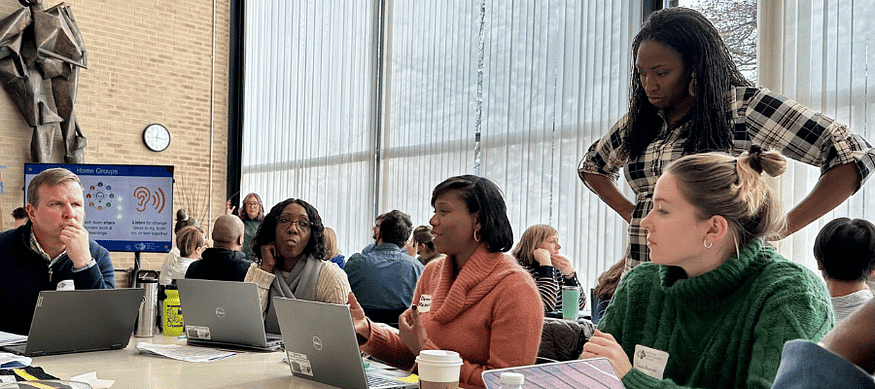Published on Jan 12, 2023
Over a given school year, the Freshman Success Improvement Community (FSIC) of the Network for College Success (NCS) has supported freshman success teams in helping their high school students achieve high GPAs and On-Track rates. However, the 3rd quarter slump, a period during the school year when there is a predictable, significant drop in students’ academic performance, has continued to threaten schools’ progress.
NCS emphasizes the importance of finding ways to not only prevent the slump but also to expand possibilities for 9th graders.
Teachers in the Network for College Success Freshman Success Improvement Community meet to plan Freshman Success strategies during the Fall Term
The SEARCH Institute’s Developmental Relationships framework defines expanding possibilities as connecting young people with ideas, people, and places that inspire and broaden their horizons. This year, the start of the second semester after winter break presents a unique opportunity for a fresh start, much like an orientation at the beginning of the year.
The Freshman Success team at NCS has outlined 9 elements to supporting freshmen to be successful. Rather than leaning heavily on students to absorb a lot of material quickly, these disruptions provide opportunities for young people to develop their identities, connection to the school, and ideas for their future selves while also creating the conditions for a healthy, holistic academic environment. In addition, the elements guide the creation of activities that will disrupt the impact of the Quarter 3 slump on students while also expanding their possibilities.
The sample activities below are categorized into either weekly disruptions, which can be one dedicated day out of the week, or week-long disruptions, which are more intense and focused efforts.
1.) Physical Space & Campus Tours activities allow students to refamiliarize themselves with the school community’s spaces and resources. Consider curating campus tours or sharing information about where to go and who to go to with questions or problems.
Example of a weekly disruption: Put together a scavenger hunt for students to explore their learning environment.
Example of a week-long disruption: Host advisory field trips, allowing students to explore colleges or careers in advisory groups throughout the week.
2.) Self-Discovery and Awareness activities help students get to know themselves, recognize their strengths, and form their own opinions. These can also be opportunities to practice listening, empathy, conversation, and friendship skills.
Example of a weekly disruption: Socratic seminars and personal values exploration activities.
Example of a week-long disruption: Leadership research projects or vision board presentations.
3.) Self Confidence activities help students develop an early sense of belonging in their school and explore their personal strengths.
Example of a weekly disruption: “Future Me” letter writing or #MindfulMondays to provide meditation or reflection time.
Example of a week-long disruption: Host an Social and Emotional Learning (SEL) Week and center themes and activities to support mind, body, and reflection.
4.) Leadership Skills & Dispositions activities help students learn how to be good role models, build trust, and help others using gentle guidance to solve problems.
Example of a weekly disruption: Expert presentations are an excellent way for individual students to teach the class about a topic they know well. It can be anything!
Example of a week-long disruption: Service learning projects or week-long peer mentoring week.
5.) 9th-Grade Expectation activities re-establish a psychologically safe community environment while reinforcing day-to-day routines.
Example of a weekly disruption: Take a day to review and recommit classroom norms and community agreements.
Example of a week-long disruption: Have students create a 9th Grade Playbook, a guide for next year’s incoming freshmen class, identifying strategies that support 9th-grade success.
6.) Academic Motivation activities include scaffolded activities for students to practice critical thinking, questioning, team collaboration, and public speaking.
Example of a weekly disruption: A concrete goal-setting activity can allow students to visualize and plan goals along with obstacles that may come up.
Example of a week-long disruption: Organize students into literature circles, or small groups, to discuss a piece of literature in depth.
7.) Adult-Young Person Relationship Building activities foster developmental relationships and trust between students and adults in the school building.
Example of a weekly disruption: Throw a “Get to know your Teachers Day” along with group activities and prizes.
Example of a week-long disruption: Dedicate a week to a collaborative problem-solving task in which students identify a problem in the school community, work in teams to draft, and present potential solutions to school staff.
8.) Peer Relationship activities are just that–a chance for students to build relationships with their peers!
Example of a weekly disruption: Partner students up to offer peer feedback to each other with rubrics or checklists.
Example of a week-long disruption: Create student groups based on students’ interests and hobbies, which can meet for a week and create an end-of-week reflection/presentation.
9.) Family Communication activities engage families in community-building activities and are a chance to gather feedback regarding the school’s outreach and communication efforts.
Example of a weekly disruption: Getting acquainted activities, such as “Salt and Pepper,” an activity for students and family to interview each other and introduce to a larger group.
Example of a week-long disruption: Partner with parents to host a “Career Week,” which can be an opportunity to host seminars that introduce students to potential career paths.
How will you and your team disrupt the 3rd quarter slump phenomenon and expand the possibilities of your 9th-grade students?
If you would like to learn more about the strategies listed above, please get in touch with us. We also encourage you to visit our resources page for related tools and follow us on social media to stay informed about our work, including upcoming programs, resources, tools, and organizational updates.
